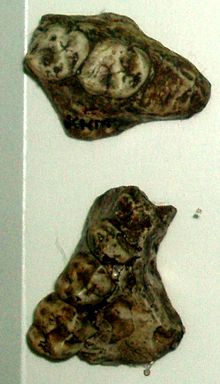| Kenyapithecus Temporal range: Middle Miocene
| |
|---|---|

| |
| Kenyapithecus wickeri teeth | |
| Scientific classification | |
| Domain: | Eukaryota |
| Kingdom: | Animalia |
| Phylum: | Chordata |
| Class: | Mammalia |
| Order: | Primates |
| Suborder: | Haplorhini |
| Infraorder: | Simiiformes |
| Family: | Hominidae |
| Subfamily: | Homininae |
| Genus: | †Kenyapithecus Leakey, 1961[1] |
| Species: | †K. wickeri
|
| Binomial name | |
| †Kenyapithecus wickeri Leakey, 1961
| |
Kenyapithecus wickeri is a fossil ape discovered by Louis Leakey in 1961 at a site called Fort Ternan in Kenya. The upper jaw and teeth were dated to 14 million years ago.[2] One theory states that Kenyapithecus may be the common ancestor of all the great apes. More recent investigations suggest Kenyapithecus is more primitive than that and is only slightly more modern than Proconsul, which is considered to be an ape.
Evidence suggests that Kenyapithecus wickeri was one of the species that started a radiation of apes out of Africa.
- ^ Ward, S.C. and Duren, D. L. (2002) "Middle and Late Miocene African Hominoids". In Hartwig, W.C. ed. The Primate Fossil Record. Cambridge University Press
- ^ L. S. B. Leakey: A new Lower Pliocene fossil primate from Kenya. In: The Annals & Magazine of Natural History, Vol. 4, Series 13, 1961, pp. 689–696